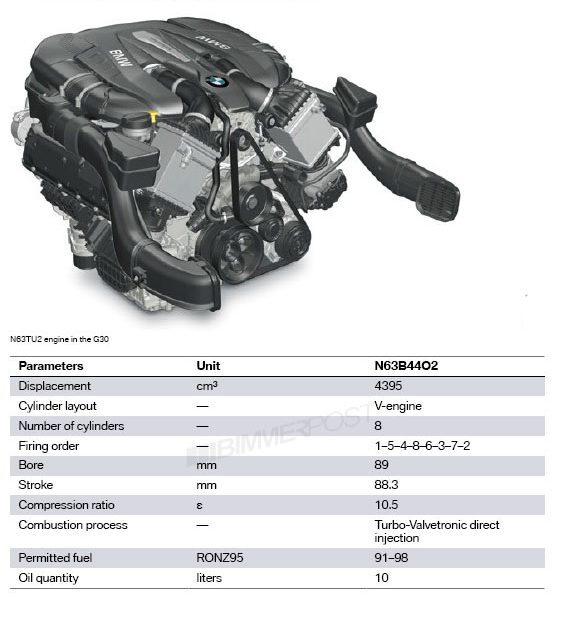The BMW N63 engine is one of the most innovative powertrains BMW has developed. Introduced in 2008, this twin-turbocharged V8 engine has powered many high-performance BMW models, offering a blend of power, efficiency, and technological advancements.
One of the core mechanical details needed to understand this engine’s functionality is its firing order.
This article explains the BMW N63 firing order, its significance, mechanical arrangement, and troubleshooting considerations.

Quick Navigation
BMW N63 Firing Order Explained
The firing order for the BMW N63 engine is 1-5-4-8-6-3-7-2. This sequence ensures optimal balance and efficiency in the V8 engine.

How the Firing Order Works:
- Cylinder numbering: BMW numbers its cylinders from front to rear, with Bank 1 (driver’s side) containing cylinders 1-4 and Bank 2 (passenger’s side) containing cylinders 5-8.
- Sequence pattern: The firing alternates between the banks to balance power delivery and reduce engine vibrations.
Understanding the Basics of the N63 Engine
The N63 is a 4.4-liter V8 engine featuring BMW’s pioneering “Hot-V” turbocharger configuration. In this design, the twin turbochargers are placed between the engine’s two-cylinder banks, minimizing turbo lag and improving throttle response.
Key Specifications:
- Engine type: Twin-turbocharged V8
- Displacement: 4.4 liters
- Valvetrain: DOHC, 4 valves per cylinder
- Cylinder bank angle: 90 degrees
Importance of the Firing Order
The firing order determines the sequence in which each cylinder ignites. Proper firing ensures smooth engine operation, prevents vibrations, and maximizes power output.
Why the Firing Order Matters
The firing order directly influences the engine’s performance, efficiency, and longevity. Here’s how:
Performance Optimization
The specific sequence minimizes vibrations and allows the engine to run smoothly at high RPMs, which is crucial for high-performance vehicles.
Thermal Management
In the N63’s Hot-V configuration, the firing order helps evenly distribute heat between the cylinder banks, preventing hotspots and improving the durability of critical engine components.
Fuel Efficiency
The firing order works in tandem with BMW’s advanced fuel injection system to ensure even combustion and reduce fuel waste.
Troubleshooting Firing Order Issues
Incorrect firing can result in performance problems, rough idling, or even damage to engine components. Below are critical signs and solutions related to firing order issues:
Common Symptoms
- Misfires: Uneven power delivery or sputtering during acceleration.
- Vibrations: Increased engine vibrations at idle or higher RPMs.
- Check Engine Light: Diagnostic codes indicating cylinder misfires (e.g., P0300 or P030x codes).
Potential Causes
- Faulty Ignition Coils: Damaged coils can disrupt the firing sequence.
- Spark Plug Issues: Worn or fouled plugs may prevent proper ignition.
- Wiring Problems: Faulty or disconnected wiring can interfere with ignition timing.
Recommended Solutions
- Inspect ignition coils and spark plugs: Replace any damaged components.
- Check wiring connections: Ensure proper connections to the engine control unit (ECU).
- ECU diagnosis: Use a diagnostic tool to identify misfire codes and address underlying issues.
How the Firing Order Impacts Maintenance
Understanding the firing order simplifies troubleshooting and engine maintenance. Mechanics rely on the firing sequence to pinpoint misfiring cylinders and optimize engine tuning.
Key Maintenance Tips
- Spark plug replacement interval: Replace every 60,000 to 100,000 miles, depending on driving conditions.
- Ignition coil inspection: Test coils regularly for proper function.
- Engine diagnostics: Use specialized BMW diagnostic tools to monitor cylinder performance.
Innovations in N63 Engine Firing Dynamics
BMW incorporates cutting-edge technologies in the N63 engine to enhance firing efficiency and performance.
Valvetronic System
BMW’s Valvetronic system adjusts valve timing to optimize combustion. This innovation complements the firing order, ensuring smooth engine operation under various loads.
Twin-Turbocharging
The firing order works seamlessly with the N63’s twin turbochargers, ensuring consistent power delivery and reducing turbo lag.
FAQs About BMW N63 Firing Order
Can the firing order of the N63 engine change?
No, the firing order is mechanically fixed and cannot change. Any alteration would require significant modifications to the engine’s design and software.
How can I identify a misfiring cylinder in the N63?
A diagnostic scan tool can read trouble codes and identify the specific cylinder experiencing misfires.
Does the firing order affect exhaust sound?
Yes, the firing order influences the exhaust note, creating the distinct sound associated with BMW’s V8 engines.
Engines with Similar Firing Orders
Conclusion
The BMW N63 firing order of 1-5-4-8-6-3-7-2 plays a vital role in the engine’s performance, balance, and efficiency. Whether you’re maintaining your BMW or troubleshooting engine issues, understanding the firing order simplifies diagnostics and ensures smoother operation.
Proper maintenance of ignition components and adherence to BMW’s service guidelines will help you get the most out of this advanced V8 engine.

